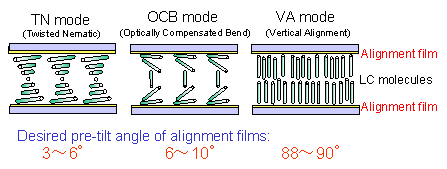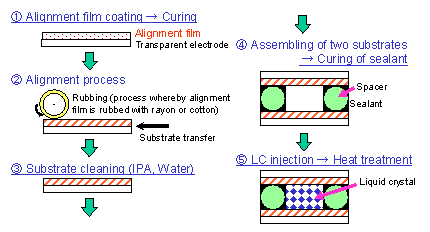JSR awarded CSJ's 58th Award for Technical Development 2009
- Development and industrialization of alignment film materials for use in LCD televisions -
 01/22/2010
01/22/2010
JSR Corporation (President: Mitsunobu Koshiba) was awarded The Chemical Society of Japan's (CSJ) 58th Award for Technical Development. The prize was awarded for JSR's accomplishment in "Development and Industrialization of Novel Alignment Films with Steroidal Structure for Liquid Crystal Display (LCD) Televisions (TVs)." JSR was recognized for developing a useful material leading to the realization of LCD TVs, in addition to the material's industrialization. JSR's high technological value in greatly contributing to the popularization of today's LCD TVs and the likelihood that it will have an increasingly extensive application in the coming future, were likewise appraised. The award ceremony will be held on March 27 (Saturday), during the CSJ's 90th Annual Meeting (Dates: March 26 - 28; Venue: Kinki University Main Campus, Higashi-Osaka City). In addition, details of the alignment film will be delivered during the same meeting on March 28 (Sunday).
An alignment film is a material used for the unidirectional alignment of liquid crystal (LC) molecules; these molecules are located between the glass substrates used inside the LCD panels [refer to diagram 2]. Alignment films are an important component as they influence the display performance of LCD panels. When LCD panels first appeared on the market, they were used as small display panels in devices such as digital clocks and personal computers; however, in order to extend the use of LCD panels to large-screen LCD TVs later, it became essential for alignment films to become technically advanced.
The award-winning alignment film material consists of JSR's own long-established special polyimide (organic-solvent-soluble polyimide) using a newly-developed diamine compound with a steroidal structure. Since the product's development in the 1990s, it has continued to improve. These technologies have been issued with patents both domestically (Japanese Patent No. 2893671) and abroad, such as the U.S.A (U.S. Patent 5276132).
In putting LCD TVs into practical use, a major impediment was in controlling the pre-tilt angle of LC molecules located between the glass substrates. In applying these alignment film materials to LCD panels, stable and precise control of the pre-tilt angle was achieved. This technology improved the contrast (black/white luminance ratio) of LCD TVs, enabling a clear image even when viewing the screen in a brightly-lit room. Additionally, in widening the viewing angle of LCD TVs, an issue (screen color would change when looked at from different angles) was resolved.
Furthermore, in early-model LCD TVs, graphics such as fast-moving images would cause a motion blur to appear. However, these technologies have caused a major improvement and as a result, current-model LCD TVs now have the same image quality as CRT-based TVs. Currently, the majority of large-screen LCD TVs have adopted the use of these alignment films with these technologies.
The CSJ was founded in 1878, encompassing a history and tradition of over 130 years. With a membership of approximately 32,000, it is the largest chemistry-related society in Japan. Every year, the CSJ offers awards to organizations and individuals for their distinguished achievements in research, both in academic and industrial fields. Of these awards, the Award for Technical Development is granted to organizations or individuals with particularly notable achievements for chemical engineering technologies in Japan.
Reference materials:
1. Award recipients:
Yasuo Matsuki - Manager, Tsukuba Research Laboratories, JSR Corporation.
Michinori Nishikawa - General Manager, LCD Materials 2nd Lab., Display Materials Research Laboratories, JSR Corporation.
Shigeo Kawamura - Manager, LCD Materials Department, Display Materials Division, JSR Corporation.
Keiichi Yamamoto - Tsukuba Research Laboratories, JSR Corporation.
Yasuaki Mutsuga - Performance Polymers Lab., Yokkaichi Research Center, JSR Corporation.
2. Cross-sectional diagram of a liquid crystal display (LCD) panel:
3. Typical fabrication method of an LCD:
4. Various types of LCD panels for use in TVs:

An alignment film is a material used for the unidirectional alignment of liquid crystal (LC) molecules; these molecules are located between the glass substrates used inside the LCD panels [refer to diagram 2]. Alignment films are an important component as they influence the display performance of LCD panels. When LCD panels first appeared on the market, they were used as small display panels in devices such as digital clocks and personal computers; however, in order to extend the use of LCD panels to large-screen LCD TVs later, it became essential for alignment films to become technically advanced.
The award-winning alignment film material consists of JSR's own long-established special polyimide (organic-solvent-soluble polyimide) using a newly-developed diamine compound with a steroidal structure. Since the product's development in the 1990s, it has continued to improve. These technologies have been issued with patents both domestically (Japanese Patent No. 2893671) and abroad, such as the U.S.A (U.S. Patent 5276132).
In putting LCD TVs into practical use, a major impediment was in controlling the pre-tilt angle of LC molecules located between the glass substrates. In applying these alignment film materials to LCD panels, stable and precise control of the pre-tilt angle was achieved. This technology improved the contrast (black/white luminance ratio) of LCD TVs, enabling a clear image even when viewing the screen in a brightly-lit room. Additionally, in widening the viewing angle of LCD TVs, an issue (screen color would change when looked at from different angles) was resolved.
Furthermore, in early-model LCD TVs, graphics such as fast-moving images would cause a motion blur to appear. However, these technologies have caused a major improvement and as a result, current-model LCD TVs now have the same image quality as CRT-based TVs. Currently, the majority of large-screen LCD TVs have adopted the use of these alignment films with these technologies.
The CSJ was founded in 1878, encompassing a history and tradition of over 130 years. With a membership of approximately 32,000, it is the largest chemistry-related society in Japan. Every year, the CSJ offers awards to organizations and individuals for their distinguished achievements in research, both in academic and industrial fields. Of these awards, the Award for Technical Development is granted to organizations or individuals with particularly notable achievements for chemical engineering technologies in Japan.
Reference materials:
1. Award recipients:
Yasuo Matsuki - Manager, Tsukuba Research Laboratories, JSR Corporation.
Michinori Nishikawa - General Manager, LCD Materials 2nd Lab., Display Materials Research Laboratories, JSR Corporation.
Shigeo Kawamura - Manager, LCD Materials Department, Display Materials Division, JSR Corporation.
Keiichi Yamamoto - Tsukuba Research Laboratories, JSR Corporation.
Yasuaki Mutsuga - Performance Polymers Lab., Yokkaichi Research Center, JSR Corporation.
2. Cross-sectional diagram of a liquid crystal display (LCD) panel:
 | ← An alignment film is a thin-film material which controls the alignment of liquid crystal molecules |
3. Typical fabrication method of an LCD:
 |
|
4. Various types of LCD panels for use in TVs:





